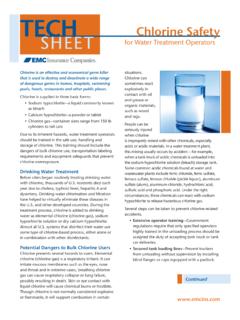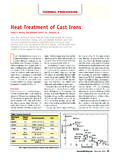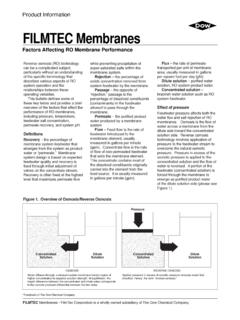Transcription of Water Treatment for Cooling Towers (1 of 2) Email …
1 Water Treatment for Cooling Towers (1 of 2) Page 1 of 4. Search HPAC & the HPAC Engineering Web Advanced Search Email a Colleague Water Treatment for Cooling Towers (1 of 2) Print This Article Water Treatment helps ensure that heat-transfer surfaces perform to design specifications Reprints/Licensing By Amanda Meitz, Senior Microbiologist, Nalco Diversified Technologies, Inc. As the universal solvent, Water is capable of dissolving a variety of materials as well as holding comparatively high concentrations of dissolved matter in solution. Over the ages, Water has also provided a method for transporting materials from one place to another--sometimes as a result of natural flooding-- frequently through the application of human ingenuity, and canal/lock systems. Both ancient and modern manufacturing practices have taken advantage of both the solvent and transport capabilities of Water . Another characteristic of Water is the ability to collect, hold, and transport heat.
2 Accordingly, the abundant volume of Water on the earth's surface plays an important role in weather patterns and temperatures. The comparatively easy availability of Water and its relatively low cost make it useful for comfort heating and Cooling of buildings. The purpose of this article is to review the characteristics of Water that impact its use in Cooling Water systems. Procedures and methods for coping with some of the solutes and particulates associated with Water as they may impact a building's Cooling Water systems are discussed. Water as heat transfer fluid Swimmers and other Water -sport enthusiasts are familiar with the role of Water acting as a Cooling agent as Water evaporates from swimsuits or clothes. To cool a building, the same principle is used. Water is exposed to moving air so that a portion of the Water evaporates, which results in Cooling the remaining Water . The open recirculating loop of the Cooling system is comprised of the Cooling tower and piping to and from the chiller or heat exchanger.
3 Fig. 1 depicts an example of a 1000 gal open recirculating Cooling loop where Water collects heat from the chiller leaving the chiller at 95 F. Warm Water pumped to the Cooling tower falls about 10 ft to the basin of the Cooling tower where the temperature is 85 F. The 10 F temperature change is the result of evaporation of about 3 gpm from the recirculating Water . Recirculation rate (RR) is about 300. gpm; the entire volume of the 1000 gal system flows through the Cooling tower every 3 min. A small percentage of the recirculation rate (RR = 300 gpm, in our example) is lost to drift or windage where the Water leaves the Cooling tower as a droplet rather than as a vapor. Mechanically intact drift or mist eliminators are important barriers to Water leaving Cooling Towers as liquid. A mechanically intact, clean, Cooling tower fill provides the necessary surface area so that air and Water mix efficiently, and Water leaves the Cooling tower as Water vapor and Water droplet generation are minimized.
4 For modern, high-efficiency Cooling Towers , drift is about times the recirculation rate or about gpm in our example. For older Cooling Towers or Towers in poor repair with broken or missing drift eliminators or fill, more liquid is lost. At the extreme for Water droplet loss is the spray pond that loses times the recirculation rate or gpm, if a spray pond replaced the Cooling tower in our example. Note that only the Water leaves the Cooling tower by evaporation; the materials dissolved in the Water remain behind. Conversely, Water that leaves as liquid Water droplets "drift" or "mist" can carry dissolved and particulate materials. In addition to the lost energy efficiency, Cooling tower drift has been implicated as a source for Legionnaires' disease--hence, the importance of maintaining the Cooling tower in excellent mechanical condition with intact fill and drift eliminators and a fan that is balanced and does not create additional droplets.
5 1 Simplified schematic of open recirculating and closed loops that provide comfort Cooling to an office building. Since Water is continuously being evaporated and lost as mist, makeup Water must be added to the Cooling tower--usually to the basin. The Water level in the basin is controlled by a float valve so that entering makeup Water is provided as needed. Because evaporation removes only Water and not dissolved or particulate materials, evaporation cannot be done indefinitely without concomitant "bleed" or "blowdown." Bleed or blowdown is a controlled Water loss from the system so that the dissolved materials do not accumulate in the Cooling system. The amount of bleed required for a Cooling system is heavily dependent upon the quality of the makeup Water , particularly the calcium concentration. Bleed requirements and methods to control bleed are discussed below. Fig. 1 shows the relationship of temperature and evaporation rates in our 1000 gal generalized Cooling 1/31/2008.
6 Water Treatment for Cooling Towers (1 of 2) Page 2 of 4. system. It also shows the closed loop generally associated with Cooling systems. The role of the closed loop is to circulate Water through the air handlers or other heat-exchange devices (apparatus necessary to cool computer rooms is a good example) and collect waste heat by increasing the temperature of the Water in the closed loop. The refrigeration cycle in the chiller transfers the heat to the open recirculating system where it is discharged to the atmosphere. Water as solvent A solute is a material that has been dissolved in a solvent. Solutes may be solids, liquids, or gases. Solvents frequently are liquids. When coffee is made, organic compounds extracted from the coffee grounds are the solutes, and Water is the solvent. If sugar is added to coffee, the sugar is an additional solute. The coffee will contain many solutes--ions originally dissolved in the tap Water used to make the coffee; numerous different organic compounds from the coffee beans; and the dissolved sugar, a well studied organic compound.
7 Concentrations of solutes in natural waters depend on the geology of the area in which the Water is found. Some regions of the earth, such as the northeastern , have igneous rock as the primary geological component from which soil was made over centuries of weathering. Other regions of the country have more sedimentary rock--limestone being the predominant example. Limestone is comprised primarily of calcium carbonate that can dissolve readily and produce "hard Water ." The hardness ions are calcium and magnesium, both of which are positively charged. Since charges must be balanced, negative charges must also be present. The predominant negative charges are carbonate and bicarbonate. Water flowing through regions of igneous rock tend to be soft waters containing relatively little calcium, magnesium, and carbonate. Since calcium, magnesium, and carbonate were found together so frequently and early chemical detection methods could not readily distinguish the three species, all three compounds today are expressed as CaCO3 for many Water Treatment applications.
8 Examples of hard Water , moderate hardness Water , and soft Water are shown in Table 1. Note that total hardness as calcium carbonate is the sum of calcium hardness and magnesium hardness, both expressed as calcium carbonate. Since these materials can be dissolved from rock, it should not be unexpected that they would precipitate again from waters that contain appreciable concentrations to produce rock-like substances on surfaces. 2a. A 2 in. diameter copper pipe lined with about 1 in. of scale. Calcium carbonate deposits in pipes or heat-exchange surfaces can impede both Water flow and heat exchange. Fig. 2a is an example of a scaled pipe with a decreased inner diameter. Decreasing the diameter of a pipe by having a calcium carbonate deposit slows down the Water , allowing more calcium carbonate to deposit along the surface. Calcium carbonate deposits along tubing surfaces in heat exchangers or chillers insulate the Water from the pipe and diminish heat transfer from the Water to the pipe.
9 If heat is not effectively transferred across the metal, it does not reach the refrigerant or other heat sink on the other side of the metal pipe. Higher energy costs and more equipment wear result. Fig. 2b shows pieces of scale that were deposited along a large diameter pipe. These "chips" are about 1 by 3 cm ( by 1 in.) with the slight curvature of the large pipe where they were deposited before they broke off. Chips of this size can block flow through chiller tubing and clog distribution holes on Cooling tower decks. 2b. Curved scale chips that broke away from a large diameter pipe. Additional solutes of interest in Water Treatment are chloride and sulfate. Chloride is used as a method to measure cycles of concentration. Historically, sulfate along with pH have been indicators of whether sulfuric acid was added to the system. Sodium and potassium are two other cations (positively charged solutes). found in natural waters.
10 Sodium and potassium concentrations are not routinely monitored by Water treaters because both are so soluble that precipitation with anions is rare. Also, atomic absorption spectroscopy is the usual way to quantify these two cations and easy field-test methods do not exist. Both are important contributors to conductivity measurements. Silica can form silicate deposits particularly in boiler systems or heated loops. If silicate deposits are formed, removal is particularly difficult. Silica deposits are insulators. Glass fiber insulation is a silica deposit devised for its ability to minimize air movement and heat transfer. Having silica concentrations in the recirculating Water at the expected levels demonstrates that silica deposits are not forming. Silica arrives in Cooling systems with makeup Water and particulate sand that are drawn into the Cooling tower. Silicate is used as a component of some corrosion-inhibitor formulations.





